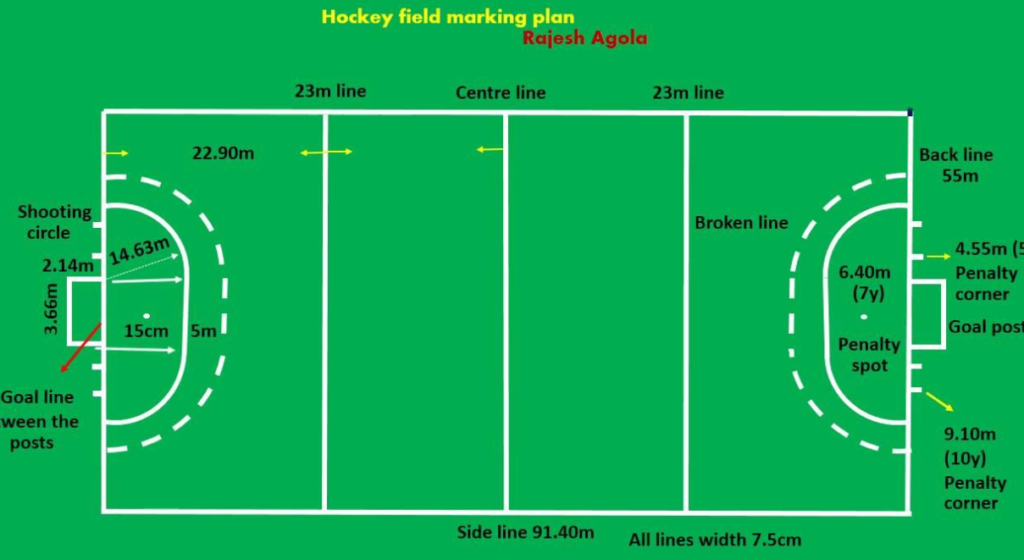Soccer Field Size in Feet A standard soccer field measures 360 feet in length and 225 feet in width. This makes the total size of a soccer field in feet approximately 81,000 square feet.
The size of a soccer field is crucial for organizing and playing the game effectively, ensuring fair play and adherence to regulations. Soccer, also known as football in many countries, is a sport enjoyed by millions across the globe. The dimensions of a soccer field are standardized to ensure consistency and fairness in the game.
Understanding the size of a soccer field in feet is essential for players, coaches, and organizers to plan and execute matches effectively. We will delve into the specific measurements of a soccer field, the importance of adhering to these dimensions, and how they impact the game at various levels. Understanding the size of a soccer field in feet is fundamental for anyone involved in the sport, from amateurs to professionals.
History of Soccer Field Size

In the evolution of soccer, the dimensions of the soccer field have played a crucial role in shaping the game. Understanding the history of soccer field size provides insights into how the sport has evolved.
Table of Contents
Evolution of Soccer Field Dimensions
The evolution of soccer field dimensions has been a gradual process influenced by various factors such as tradition, regulations, and player safety. From the early days of soccer to the modern era, the size of the soccer field has undergone significant changes.
Impact of Field Size on Game Dynamics
The field size in soccer directly impacts the dynamics of the game. A larger field allows for more space and encourages strategic plays, while a smaller field promotes quicker decision-making and tighter gameplay. Understanding how field size influences game dynamics is essential for players and coaches.
Standard Soccer Field Measurements
Soccer field size in feet is a crucial aspect of the game. The standard soccer field measurements are 100 to 130 yards in length and 50 to 100 yards in width, providing ample space for players to showcase their skills and tactics.
Soccer, also known as football in some countries, is a popular sport played worldwide. The game is played on a rectangular field with specific dimensions. The standard soccer field measurements are regulated by FIFA, the international governing body of soccer. The field size may vary based on the level of play, but the dimensions of a regulated soccer field remain the same.
Regulation Field Size
The regulation soccer field size is 100-130 yards in length and 50-100 yards in width. This means that the length of a soccer field can vary between 300 and 390 feet, while the width can vary between 150 and 300 feet. The soccer field is divided into two halves, each half is 45-90 yards wide. The center of the field has a circular center spot with a radius of 10 yards. The goal area is 6 yards from each goal post and 20 yards wide.
Variations in Field Dimensions
The size of a soccer field may vary depending on the level of play. High school fields may be smaller than regulation fields, and youth fields may be even smaller. Indoor soccer fields also have different dimensions. However, the basic layout of a soccer field remains the same. The goals are always 8 yards wide and 8 feet tall, and the distance between the goalposts is always 24 feet. In conclusion, understanding the standard soccer field measurements is crucial for players, coaches, and officials. By knowing the correct dimensions of a soccer field, everyone can ensure that the game is played fairly and safely. Whether you’re playing on a regulation field or a smaller one, the rules and layout of the field remain the same.
Key Components of a Soccer Field
The soccer field size in feet can vary but typically ranges from 100-130 yards in length and 50-100 yards in width. The goal area is essential, measuring 6 yards from the goal post and 18 yards wide. The penalty area is 18 yards from the goal line and 44 yards wide.
Soccer fields vary in size, with dimensions typically measured in feet and meters. Understanding the key components of a soccer field is crucial for players and fans alike. Let’s explore the essential elements that make up a standard soccer field.
Goal Posts
Goal posts are a fundamental feature of any soccer field. They are positioned at each end of the field and serve as the target for players to score goals. The standard distance between the two goalposts is 8 feet by 8 yards.
Penalty Area and Penalty Spot
The penalty area is a critical zone on the soccer field where certain fouls result in a penalty kick. It is marked by distinct lines and dimensions, including the penalty spot. The penalty spot is located 12 yards away from the goal line.
Center Circle
The center circle is located at the midpoint of the field and serves as the starting point for the game. It has a radius of 10 yards and is where the initial kickoff takes place. Understanding these key components of a soccer field helps players and spectators appreciate the layout and dimensions of the playing surface. Soccer field size in feet is vital for players to strategize and execute their game plan effectively.
Factors Influencing Field Size
Factors influencing soccer field size in feet can vary based on regulations set by governing bodies like FIFA. Dimensions typically range from 100-130 yards in length and 50-100 yards in width, impacting gameplay and player dynamics. The field’s size is crucial for strategy and overall match experience.
Factors Influencing Field Size When it comes to soccer field size in feet, several factors influence the dimensions of the field. FIFA regulations and local constraints and considerations play a significant role in determining the size of a soccer field. Understanding these factors is crucial for ensuring that the field meets the necessary standards and provides an optimal playing environment for the athletes.
Fifa Regulations
FIFA, the international governing body of football, has established specific regulations regarding the dimensions of a soccer field. According to FIFA guidelines, a standard soccer field should have a length between 100 yards and 130 yards and a width between 50 yards and 100 yards. These regulations ensure consistency and fairness in the game, allowing players to adapt to the standard field size regardless of the location.
Local Constraints and Considerations
Local constraints and considerations also play a crucial role in determining the size of a soccer field. Factors such as available space, land cost, and community needs can influence the dimensions of the field. In urban areas, where space is limited, soccer fields may be smaller to accommodate the surrounding environment. On the other hand, in rural areas with ample space, larger fields may be constructed to meet the demand for recreational and competitive play. In conclusion, understanding the factors that influence soccer field size is essential for creating a suitable and standardized playing environment. By adhering to FIFA regulations and considering local constraints, the dimensions of a soccer field can be optimized to provide an enjoyable and competitive experience for players and spectators alike.
Comparison with other Sports Fields
Soccer fields vary in size, with the standard measurements ranging between 100-130 yards in length and 50-100 yards in width. These dimensions make soccer fields larger than those of other sports, such as football and rugby, providing a spacious playing area for the sport.
Soccer Field Vs. Football Field
The size of a soccer field is often compared to that of a football field. While a soccer field measures approximately 100-130 yards in length and 50-100 yards in width, a standard American football field is 120 yards long and 53.3 yards wide. This makes a soccer field slightly larger than a football field in terms of overall area.
Soccer Field Vs. Rugby Field
Soccer Field Size in Feet

When comparing a soccer field to a rugby field, there are notable differences in size. A rugby field typically measures between 94-144 meters in length and 68-70 meters in width, making it larger than a standard soccer field. The distinct dimensions cater to the specific requirements and gameplay of each sport.
Significance of Field Size in Strategy
The size of a soccer field plays a crucial role in determining the strategies and tactics employed by teams. Understanding the significance of field size is essential for coaches and players to optimize their performance and gameplay based on the dimensions they are playing on.
Tactical Considerations
The dimensions of a soccer field, such as high school soccer field dimensions in feet, directly impact the tactical approach of a team. A larger field allows for more space and encourages a possession-based style of play, while a smaller field favors a more compact and defensive strategy.
Player Positioning
Soccer field size in feet also influences player positioning and movement. On a larger field, players have to cover more ground, requiring a higher level of endurance and strategic positioning to maintain effective defensive and offensive structures.
Innovations in Field Design
When it comes to soccer field size in feet, the innovations in field design have led to advancements in creating more sustainable and efficient playing surfaces. These innovations aim to enhance player performance, reduce environmental impact, and provide a better overall experience for athletes and spectators. Let’s explore some of the latest developments in soccer field design.
Hybrid Turf Systems
Hybrid turf systems have revolutionized soccer field dimensions, offering a blend of natural grass and synthetic fibers to improve durability and playing conditions. The integration of hybrid turf has significantly extended the lifespan of fields and reduced maintenance costs, making it a popular choice for many high school soccer field dimensions in feet and professional stadiums alike.
Sustainable Field Materials
Utilizing sustainable materials in soccer field construction has become a priority for many organizations. From recycled rubber infill to eco-friendly artificial turf, the use of sustainable field materials not only minimizes environmental impact but also enhances the longevity of the playing surface. These materials are increasingly being incorporated into youth soccer field-size in feet to promote eco-conscious practices from an early age.
Future Trends in Soccer Field Development
https://jobsinfootball.com/blog/soccer-field-dimensions/Soccer field development is constantly evolving to meet the changing demands of the sport. Future trends in this field focus on advancements in technology and adaptations for climate change.
Technological Advancements

Incorporating advanced technology into soccer field design is a key trend for the future. From state-of-the-art turf systems to smart pitch monitoring tools, technology is revolutionizing the way soccer fields are constructed and maintained.
Adaptations for Climate Change
With the increasing impact of climate change, soccer field development is shifting towards more sustainable and resilient practices. This includes implementing eco-friendly turf solutions, water-saving irrigation systems, and heat-resistant materials to combat the effects of rising temperatures.
Conclusion
Understanding the dimensions of a soccer field in feet is crucial for players and fans alike. Proper knowledge enhances the game experience and appreciation for the sport. By knowing the size, one can better strategize and appreciate the intricacies of soccer.

